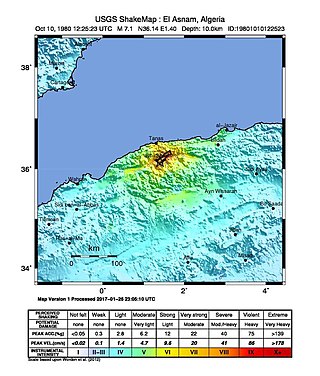The 1921 Massawa earthquake took place off the coast of Massawa, Eritrea, on August 14 with a moment magnitude of 6.1 and a Mercalli intensity of VIII (Severe). The first aftershock after the initial earthquake was of similar magnitude. Significant damage was caused to the harbour at Massawa with a number of deaths reported. Aftershocks were felt as far away as Asmara and Dekemhare.
The 2003 Colima earthquake occurred on 21 January with a moment magnitude of 7.6 and a maximum Mercalli intensity of VIII (Severe). The epicenter was located on the Pacific coast in the Mexican state of Colima. The earthquake was felt as far away as Mexico City and in southern parts of the United States.
The 1933 Diexi earthquake occurred in Diexi, Mao County, Sichuan, Republic of China on August 25 with a moment magnitude of 7.3 and a maximum Mercalli intensity of X (Extreme). With up to 9,300 killed, this was the deadliest earthquake in 1933.
The 1967 Koynanagar earthquake occurred near Koynanagar town in Maharashtra, India on 11 December local time. The magnitude 6.6 shock hit with a maximum Mercalli intensity of VIII (Severe). It occurred near the site of Koyna dam, raising questions about induced seismicity, and claimed at least 177 lives and injured over 2,200.

The 1980 El Asnam earthquake occurred on October 10 at with a moment magnitude of 7.1 and a maximum Mercalli intensity of X (Extreme). The shock occurred in the Algerian town of El Asnam. The shocks were felt over 550 km (340 mi) away, with the initial earthquake lasting 35 seconds. It was the largest earthquake in Algeria, and was followed three hours later by a magnitude 6.2 aftershock. The earthquake created about 42 km (26 mi) of surface rupture and had a vertical slip of up to 4.2 m (14 ft). No foreshocks were recorded. The earthquake was found to have occurred very close to the epicenter of the 1954 Chlef earthquake using joint epicenter determination techniques. It occurred at a previously unknown reverse fault.
The 2003 Altai earthquake, or 2003 Chuya earthquake, occurred on September 27 at with a moment magnitude of 7.3 and a maximum Mercalli intensity of X (Extreme). The epicenter of this oblique-slip shock was in Altai Republic, Russia near the borders of Mongolia, China, and Kazakhstan. Three deaths and five injuries were reported and the total damage was listed as $10.6–33 million.
The 1973 Veracruz earthquake, also known as El Terremoto de Orizaba, occurred at 3:50 a.m. local time on August 28, 1973, with the epicenter located in the vicinity of Ciudad Serdán in the Mexican state of Puebla. It registered 7.1 on the moment magnitude scale and had a maximum perceived intensity of VIII (Severe) on the Mercalli intensity scale. The effects were felt in the states of Veracruz and Puebla in southeast Mexico.
The 1935 Digor earthquake occurred on 1 May at Digor, Kars in the Eastern Anatolia region of Turkey. It had a moment magnitude of 6.1 and caused 540 fatalities.

The 1975 Hawaii earthquake occurred on November 29 with a moment magnitude of 7.7 and a maximum Mercalli intensity of VIII (Severe). The shock affected several of the Hawaiian Islands and resulted in the deaths of two people and up to 28 injured. Significant damage occurred in the southern part of the Big Island totalling $4–4.1 million, and it also triggered a small brief eruption of Kilauea volcano.
The 2004 Nabire earthquake occurred on November 26 in Nabire Regency, Central Papua, Indonesia. The strike-slip event had a moment magnitude of 7.1 and a maximum Mercalli intensity of VIII (Severe). Total deaths for the event amounted to 32, and the total number of injured was 130–213.
The 1976 Sabah earthquake occurred at 10:56 am on 26 July near Lahad Datu in the eastern portion of Sabah, Malaysia. The moment magnitude 6.3 earthquake is one of the strongest in Malaysia to be recorded by seismic instruments. It had a focal mechanism corresponding to strike-slip faulting. While slightly larger than the 2015 Sabah earthquake, the 1976 event caused less extensive damage, in the form of cracks on several buildings and ground cracks.

The 1918 San Jacinto earthquake occurred in extreme eastern San Diego County in Southern California on April 21 at . The shock had a moment magnitude of 6.7 and a maximum Mercalli intensity of IX (Violent). Several injuries and one death occurred with total losses estimated to be $200,000.
The 1981 Golbaf earthquake occurred on June 11 at with a moment magnitude of 6.6 and a maximum Mercalli intensity of VIII+ (Severe). Total damage was considered moderate and amounted to $5 million in financial losses, with many injured and 3,000 killed.
The 2004 Baladeh earthquake occurred on May 28 in northern Iran. This dip-slip earthquake had a moment magnitude of 6.3 and a maximum Mercalli intensity of VIII (Severe). Total deaths for the event amounted to 35, with 278–400 injured, and $15.4 million in damage.
The 1974 Lesser Antilles earthquake occurred at on October 8 with a moment magnitude of 6.9 and a maximum Mercalli intensity of VIII (Severe). Four people were injured in what the United States' National Geophysical Data Center called a moderately destructive event.
The 1998 Aiquile earthquake occurred on May 22 at in Bolivia. This strike-slip earthquake had a moment magnitude of 6.6 and a maximum Mercalli intensity of VIII (Severe). Damage was severe, with at least 95 deaths, 50–150 injuries, and 6,900 homeless.

On November 29, 1978, a moment magnitude 7.7–7.8 earthquake struck off the coast of the southern Mexican state Oaxaca. The thrust-faulting event caused severe damage in Oaxaca and Mexico City.




